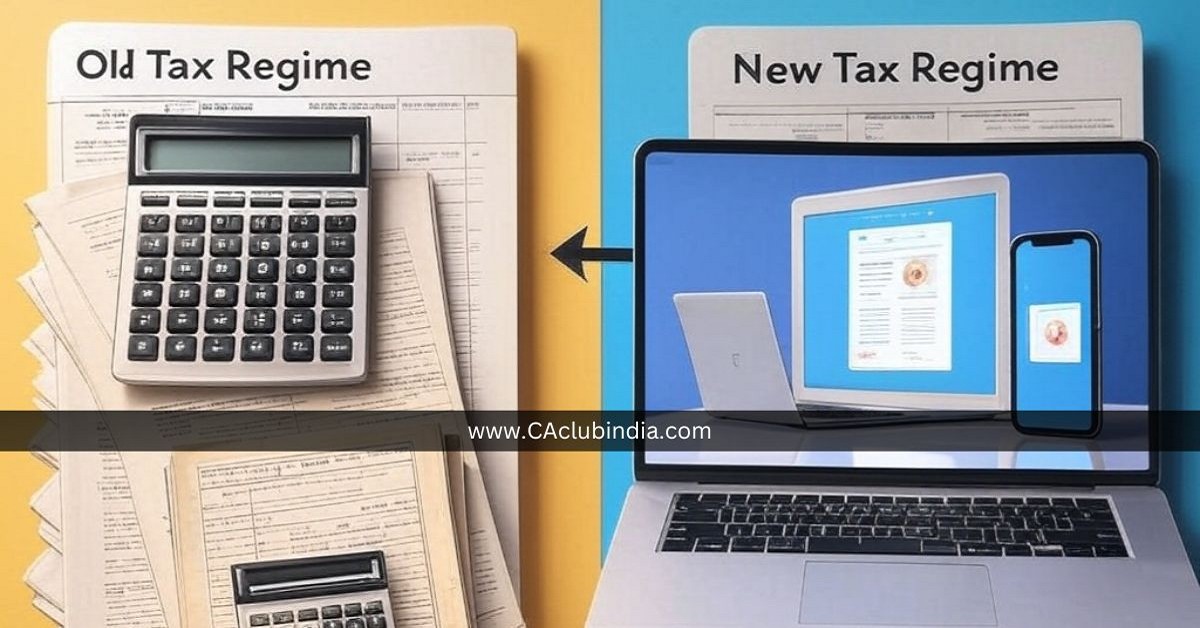Introduction
After the announcement of significant changes in the income tax slabs by the Honourable Finance Minister of India, Smt. Nirmala Sitharaman, on 1st February 2025, many salaried individuals are wondering: Which tax regime-old or new-is more beneficial for them for the Assessment Year 2026-27?
For salaried taxpayers, choosing the right tax regime is especially important, as it directly affects take-home salary and annual tax savings.
In this article, we will explore both tax regimes, compare the available exemptions and deductions, and help you make an informed decision based on your income structure and eligible benefits.

Old Tax Regime
The old tax regime offers more deductions and exemptions compared to the new tax regime, making it a preferred choice for individuals who can take advantage of these benefits. Additionally, the Budget 2025 introduced changes in tax slab rates. The applicable tax slabs under the old regime are as follows:
|
TAX SLAB |
TAX RATE (in %) |
|
Upto Rs. 2,50,000. |
0 |
|
From Rs. 2,50,001 to Rs. 5,00,000 |
5 |
|
From Rs. 5,00,001 to Rs. 10,00,000 |
20 |
|
Above Rs. 10,00,000. |
30 |
Under the old tax regime, individuals with a total income of up to Rs.5,00,000 (excluding income taxable at special rates) can claim a rebate of Rs.12,500 under Section 87A of the Income Tax Act, 1961. This effectively reduces their tax liability to zero.
Deductions and Exemptions
One of the biggest advantages of the old tax regime is the availability of various deductions that help salaried individuals reduce their taxable income. The most commonly used deduction is the standard deduction of Rs.50,000.
Deductions allowed under the head Salaries are as follows
|
Section & Name of Deductions |
Amount of Deduction allowed |
Conditions |
|
Standard deduction |
Rs. 50,000/- |
Available to all salaried individuals. |
|
Employment Tax |
Rs. 2,500/- per month |
It is allowed only if employee pays it. If the employer is paid employment tax on behalf of employee then employee didn't claim deduction for the same. |
Deductions under Chapter VI-A
In addition to salary-related deductions, several other deductions under Chapter VI-A help taxpayers lower their tax liability under the old regime. These include:
- Section 80C - Deductions for investments in PPF, EPF, Life Insurance, ELSS, NSC, etc. (up to Rs.1,50,000).
- Section 80D - Deductions for health insurance premiums paid for self and family.
- Section 80E - Deduction for interest paid on an education loan.
- Section 80TTB - Deduction for interest income earned by senior citizens.
Exemptions in the Old Tax Regime
Unlike the new tax regime, the old tax regime allows exemptions such as:
- House Rent Allowance (HRA) - Exemption available if the employee pays rent and meets the eligibility conditions.
- Leave Travel Allowance (LTA) - Exemption available for travel expenses incurred on eligible journeys.
With over 70 deductions and exemptions available, salaried individuals can significantly reduce their tax liability under the old tax regime. However, it is essential to evaluate whether claiming deductions makes the old regime more beneficial than the new one.
New Tax Regime
The new tax regime introduces wider income slabs and reduced tax rates, offering potential tax relief to salaried individuals, especially those who do not claim many deductions. The updated tax slabs, as announced in Budget 2025, are as follows:
|
TAX SLAB |
TAX RATE (in %) |
|
Upto Rs. 4,00,000. |
0 |
|
From Rs. 4,00,001 to Rs. 8,00,000 |
5 |
|
From Rs. 8,00,001 to Rs. 12,00,000 |
10 |
|
From Rs. 12,00,001 to Rs. 16,00,000 |
15 |
|
From Rs. 16,00,001 to Rs. 20,00,000 |
20 |
|
From Rs. 20,00,001 to Rs. 24,00,000 |
25 |
|
Above Rs.24,00,000. |
30 |
Under the new tax regime, individuals with a total income of up to Rs. 12,00,000 (excluding income taxable at special rates) can claim a rebate of Rs.25,000 under Section 87A of the Income Tax Act, 1961. This effectively reduces their tax liability to zero.
Deductions and Exemptions
Unlike the old regime, the new tax regime allows limited deductions and exemptions. However, a few key benefits are still available to salaried individuals and employers, as outlined below:
Standard Deduction: Rs.75,000/- is available to all salaried individuals (as per Budget 2025 amendments).
Employer's contribution to NPS [80CCD(2)]: Deduction is allowed up to 20% of salary to the employer, if contributed by the him to the National Pension Scheme (NPS).
Contribution towards Agniveer Corpus Fund [80CCH(2)}: Total contributions made by both the employee and the Central Government to the Agniveer Corpus Fund are eligible for deduction.
Recruitment of new employee [80JJAA]: Employers who hire additional employees in the formal sector can claim a deduction of 30% of additional employee cost for three consecutive assessment years. This applies to business income.
Meaning of an additional Employee
An "additional employee" refers to a person employed during the previous year, but does not include:
- Employees earning more than Rs.25,000 per month;
- Employees employed for less than 240 days (or 150 days for industries like apparel, footwear, or leather);
- Casual workers or employees not covered under Recognised Provident Fund;
- Employees whose entire contribution is paid by the government under the Employees' Pension Scheme.
Note: Under the new tax regime, most of the exemptions available in the old regime are not allowed. Key exemptions like House Rent Allowance (HRA) and Leave Travel Allowance (LTA)-which significantly benefit salaried individuals-are not available if one opts for the new regime.
However, the government has allowed a few specific allowances to continue under the new regime, primarily to reimburse actual expenses incurred in the course of employment. These four allowances permitted under the new regime are:
- Daily Allowance - Granted to meet daily expenses while on duty.
- Conveyance Allowance - For expenses incurred while performing official duties.
- Travelling Allowance - To cover travel expenses for official tours or transfers.
- Transport Allowance - Allowed only to specially-abled employees for commuting between residence and place of duty.
These are allowed to the extent of actual expenditure or specified limits and must be specifically provided by the employer.
Marginal Relief
To ease the tax burden at the rebate threshold, marginal relief is available under the new regime. If an individual's income just exceeds Rs.12,00,000/- the additional tax payable should not exceed the amount by which income exceeds Rs.12,00,000/-.
Example:- If the income of the taxpayer in an financial year is Rs.12,10,000/- then additional tax of Rs.11,000is made due to slight change in income then taxpayer can use the concept of marginal relief. Tax liability with marginal relief in this case is Rs.10,000/-
|
S.No. |
Income |
Tax payable without marginal relief |
Tax payable with Marginal Relief |
|
1 |
12,10,000 |
61,500 |
10,000 |
|
2 |
12,50,000 |
67,500 |
50,000 |
|
3 |
12,70,000 |
70,500 |
70,000 |
|
4 |
12,75,000 |
71,250 |
71,250 (No marginal relief) |
Inter-Head Set off
Under the old tax regime, a loss arising from house property-typically due to interest paid on a home loan-can be set off against income under any head, up to a maximum limit of Rs 2,00,000 in a financial year. This helps reduce the overall taxable income and is a significant benefit for taxpayers with home loans.
However, under the new tax regime, no such set-off is allowed. Loss from house property cannot be adjusted against any other income, meaning the benefit of interest deduction is effectively not available.
Quick Checklist: Which Tax Regime Should You Choose?
Use this simple checklist to evaluate which regime may be more beneficial for you:
|
Criteria |
Old Regime |
New Regime |
|
Do you claim deductions under Section 80C (e.g., PPF, LIC, EPF, ELSS, tuition fees)? |
Yes |
No |
|
Are you paying health insurance premiums (Section 80D)? |
Yes |
No |
|
Do you receive HRA and pay rent? |
Yes |
No |
|
Are you repaying an education loan (Section 80E)? |
Yes |
No |
|
Do you invest in NPS (Section 80CCD(1B) or 80CCD(2))? |
Yes |
Partial (80CCD(2) only) |
|
Do you prefer a simplified tax filing process with fewer calculations? |
No |
Yes |
|
Is your total income close to Rs.12,00,000? |
Depends (check Marginal Relief) |
Possibly beneficial |
|
Are your total deductions & exemptions less than Rs.3,00,000? |
New regime may be better |
Likely better |
Conclusion
Choosing between the old and new tax regimes for A.Y. 2026-27 depends entirely on an individual's income composition and their ability to claim deductions and exemptions.
The old tax regime remains beneficial for salaried individuals who invest in tax-saving instruments, claim HRA, LTA, and other exemptions, and can fully utilize deductions under Section 80C, 80D, and others. On the other hand, the new tax regime, with its simplified structure, wider tax slabs, higher basic exemption limit, and increased standard deduction of Rs 75,000, is ideal for those who prefer a hassle-free approach and do not avail many deductions. Before making a decision, it's important to evaluate your eligible deductions and calculate tax liability under both regimes. A comparison using actual figures will help determine which regime results in greater tax savings for your specific situation. Ultimately, the best regime is the one that aligns with your financial planning and maximizes your take-home income.






 CAclubindia
CAclubindia

